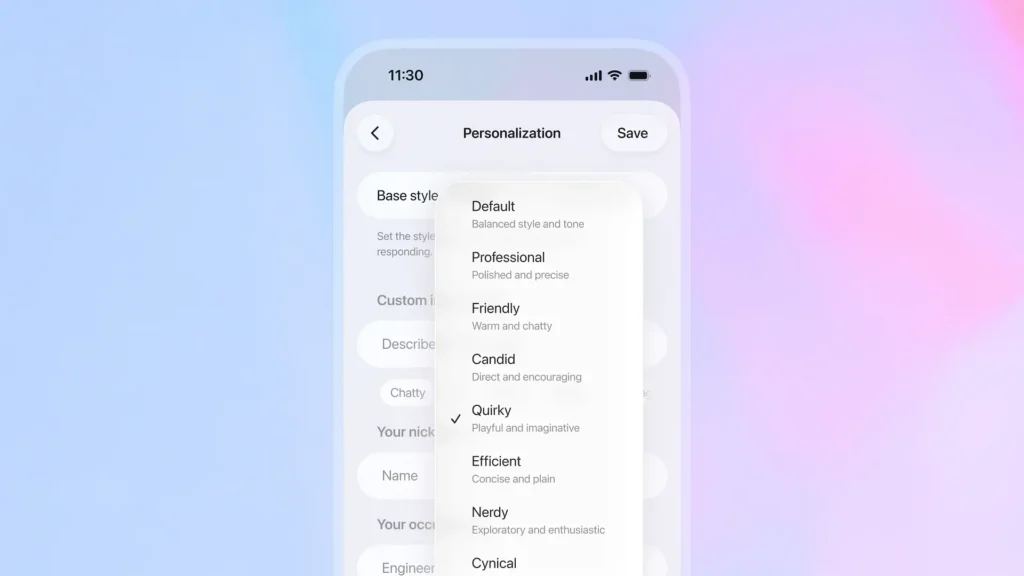What is GPT-5.1 and what updates did it bring?

On November 12, 2025, OpenAI rolled out GPT-5.1, a focused upgrade to the GPT-5 family that emphasizes conversational quality, instruction-following, and adaptive reasoning. The release reorganizes the GPT-5 lineup around two primary production variants — GPT-5.1 Instant and GPT-5.1 Thinking — and keeps the automatic routing layer (often described as Auto) that chooses the best model for a given query. Alongside the model updates, OpenAI introduced more granular personalization controls and several safety-evaluation updates.
What is GPT-5.1 and why did OpenAI release it now?
GPT-5.1 is an upgrade to the GPT-5 generation that refines two primary axes of the user experience: communication style (making answers more natural, warmer and easier to customize) and adaptive reasoning (letting the system decide — or letting you choose — how much “thinking” to apply to each prompt). OpenAI frames the release as a quality and usability update rather than a brand-new research leap: the 5.1 tag signals iterative improvements on the GPT-5 architecture.
OpenAI launched the GPT-5.1 series as an upgrade to the GPT-5 family. The public announcement describes two named variants:
- GPT-5.1 Instant — a warmer, more conversational default model that includes light adaptive reasoning (it decides when to “think” before answering) and improved instruction following.
- GPT-5.1 Thinking — the higher-reasoning version that adapts thinking time more precisely to the complexity of each request, producing deeper, clearer answers on difficult tasks while responding faster on simpler ones.
OpenAI also maintains an Auto router — GPT-5.1 Auto — that selects the best variant for a given query so end users typically don’t have to pick models manually.
GPT 5.1 will become the default version for all users in a few days, GPT 5.1 Pro is also expected to be released soon. GPT-5 will be phased out over the next three months, but can still be used temporarily in the “Legacy Models” option. GPT-5 Pro will soon be updated to GPT-5.1 Pro.
API Updates:
- gpt-5.1-chat-latest → GPT-5.1 Instant
- gpt-5.1 → GPT-5.1 Thinking (with adaptive inference)
What Sets GPT-5.1 Apart from Previous Models?
GPT-5.1 is less about a single “bigger brain” jump and more about smarter behavior selection, clearer communication, and practical controls. OpenAI’s GPT-5.1 is not a single monolithic update — it’s a family-level refinement that emphasizes adaptive reasoning, conversational quality, and easier deployment choices. The release introduced two named core variants (GPT-5.1 Instant and GPT-5.1 Thinking) plus an Auto router that picks the right variant for each query. These design choices — together with updated safety evaluations and new personalization controls — are the main things that distinguish GPT-5.1 from GPT-5 and prior models
A balanced IQ / EQ improvement
GPT-5.1 is intentionally framed as both an intelligence and communication update. The system as a whole has a more accurate understanding of human language styles, and its responses are closer to real conversations. OpenAI says it aimed to make the models smarter at instruction following and reasoning, while also making them more natural, warmer, and easier to steer—essentially improving the model’s ability to convey information in human-friendly ways. I test that is closer to the human-centered design of GPT-4o, making up for the shortcomings of GPT-5 upon its release.
OpenAI has introduced a brand-new Personalization Settings system, allowing users to quickly select the tone and personality style of ChatGPT.
Current tone options include:
- Default: Balanced and natural.
- Friendly: Warm and talkative.
- Efficient: Concise and direct.
- Professional: Formal and precise.
- Candid: Open and encouraging.
- Quirky: Creative and fun.
- Nerdy and Cynical: Retain options from the previous version.

Practical improvements (speed, clarity, adaptivity)
Technically, the release emphasizes two practical direction vectors:
- Adaptive reasoning:both variants include improved on-demand reasoning behavior — Instant decides when to “think” more deeply for a given prompt, while Thinking adjusts the amount of internal “thinking” it devotes to questions proportionally to complexity. This reduces unnecessary compute for simple tasks and gives harder tasks more attention.
- Better instruction following and clarity: Improved instruction following so the model addresses the user’s explicit request more reliably and avoids off-target verbosity. Instant is better at directly following user instructions. fewer unexplained terms, less jargon in the Thinking variant, and improved reliability in following explicit constraints.
Benchmarks and observed behavior changes
OpenAI’s internal benchmarks show improvements in instruction following, coding/math tasks, and an improved latency/quality profile for Thinking on mixed workloads. GPT-5.1 aims to “fix” tone issues reported after GPT-5, while preserving or improving reasoning capability. It significantly outperformed GPT-5 in the AIME 2025 math competition and Codeforces programming tests.

GPT-5.1 Instant vs GPT-5.1 Thinking: What are the differences?
What is GPT-5.1 Instant
GPT-5.1 Instant (model id gpt-5.1-instant) is positioned as the everyday ChatGPT model — the one most people interact with. The headline changes for Instant are:
- Warmer default tone and improved instruction following — text is tuned to be more conversational and approachable while still aiming to be useful and accurate. ([OpenAI][1])
- Adaptive reasoning: Instant can internally decide when to spend extra reasoning effort instead of always being shallow or always being deep. This gives faster responses for simple prompts while allowing depth when necessary.
- Context window (tokens / long context): smaller windows depending on plan (examples: Free 16K, Plus/Business 32K, Pro/Enterprise up to 128K).
- Safety & robustness: according to OpenAI’s production benchmark tables,
gpt-5.1-instantshows improved or comparable performance on the “Production Benchmarks” vs. earlier Instant variants for many safety categories (for example: harassment, hate, and image input evaluations). The System Card shows tabulated metrics demonstrating thatgpt-5.1-instantoutperforms some prior Instant snapshots across multiple not_unsafe metrics.
What that means for users and developers: Expect Instant to feel more natural in small-talk and coaching scenarios, better at following multi-step instructions in a single conversation turn, and to generally return answers quicker for routine tasks.
What is GPT-5.1 Thinking (key improvements and benchmark performance)?
GPT-5.1 Thinking (system id gpt-5.1-thinking) is the enhanced reasoning variant. Its improvements emphasize deliberation and clarity:
- More precise thinking time — Thinking adjusts how long it devotes to internal chains of thought depending on the task: short for trivial requests, longer for research-grade analysis or code reasoning. This reduces token/time waste on easy tasks while boosting depth where required.
- Less jargon, clearer explanations — OpenAI reports that Thinking was tuned to explain complex concepts with fewer undefined terms and less opaque phrasing, improving accessibility for non-specialist readers.
- Speed and performance: On a typical distribution of ChatGPT tasks, GPT-5.1 Thinking runs approximately twice as fast as GPT-5 Thinking on the fastest tasks, and about half as fast on the slowest tasks.
- Safety: On offline safety and production benchmarks, gpt-5.1-thinking shows comparable safety to prior thinking models with some small regressions in narrow categories that OpenAI is tracking.
Here’s a clean comparison table for GPT-5.1 Instant vs GPT-5.1 Thinking :
| Category | GPT-5.1 Instant | GPT-5.1 Thinking |
|---|---|---|
| Purpose | Fast, conversational, good at quick instruction-following and everyday tasks | Deep reasoning for complex, multi-step, or analytical problems |
| Reasoning Behavior | Light adaptive reasoning — decides when to do minimal thinking before replying | Adapts thinking time precisely; can engage in longer reasoning chains |
| Speed / Latency | Very fast, optimized for low latency | Slower on complex tasks (spends more time reasoning) |
| Response Style | Direct, concise, optimized for chat | More thorough, structured, and clear explanations |
| Context Window | Smaller (≈16 K–128 K tokens depending on plan) | Large — up to 196 K tokens |
| Best For | Everyday chat, brainstorming, short code, drafting, summarizing small docs | Research, debugging, long-document analysis, multi-step planning |
| Automatic Routing | Used by default in GPT-5.1 Auto (for most queries) | Automatically selected by Auto for harder queries |
| Manual Selection | Can be chosen directly; always faster | Can be chosen directly; limited use per week on some plans |
| Accuracy / Depth | High, but prioritizes speed | Higher reasoning accuracy for complex or long tasks |
| Trade-off Summary | ⚡ Speed > Depth | 🧠 Depth > Speed |
GPT-5.1 Auto uses signals from the prompt and conversation history — and, implicitly, learned patterns about which model tended to succeed on similar prompts — to decide whether to “think longer” or respond right away.
How can developers and teams access GPT-5.1?
Where it’s available
- ChatGPT: GPT-5.1 is rolling out to ChatGPT users (paid tiers first: Pro, Plus, Go, Business), then free accounts; Enterprise and Education customers have toggles for early access. GPT-5 models are kept in the legacy menu for a transition period so teams can compare behavior.
- API: OpenAI says GPT-5.1 models will be accessible via the platform API. Early platform communications indicate the following mapping will appear in the API: gpt-5.1-chat-latest for the Instant experience and gpt-5.1 for the Thinking variant, both exposing adaptive reasoning features in their chat endpoints.
CometAPI promises to keep track of the latest model dynamics including GPT-5.1, GPT-5.1 API will be released simultaneously with the official release. Please look forward to it and continue to pay attention to CometAPI. While waiting, you can pay attention to other models, explore the model’s capabilities in the Playground and consult the API guide for detailed instructions. Developers can access older versions of chatgpt API such as GPT-5-Codex API ,GPT-5 Pro API through CometAPI, the cometAPI’s latest models listed are as of the article’s publication date. Before accessing, please make sure you have logged in to CometAPI and obtained the API key.CometAPI offer a price far lower than the official price to help you integrate.
Ready to Go?→ Sign up for CometAPI today !
If you want to know more tips, guides and news on AI follow us on VK, X and Discord!
Conclusion: is GPT-5.1 worth upgrading to today?
Yes — if your priority is practical improvement and better conversational UX. GPT-5.1 is not a reinvention of GPT-5; it’s a thoughtful refinement: friendlier defaults, clearer instruction following, router improvements, and an explicit “Auto” switch to balance speed and depth. For most product teams and power users, it improves day-to-day reliability and tone control.


